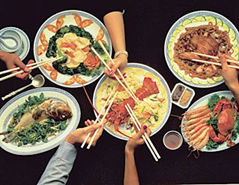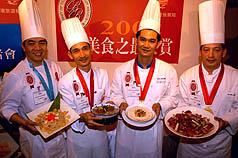Chinese Cuisine
Chinese cuisine enjoys a high reputation not only for its exquisite, delicious taste and charming appearance, but also for its sheer abundance. The diversity of the climate, products and customs introduces us to widely different food styles and tastes in local regions. Shandong cuisine emphasizes aroma, freshness, and tenderness with a strong focus on soup. Sichuan cuisine is characterized by its spicy and pungent flavors, with common ingredients of pepper and prickly ash. Cantonese food frequently uses steaming and stir-frying to preserve the ingredients' natural flavors. Fujian cuisine is renowned for its choice of seafood, beautiful color and magical tastes of sweet, sour, salt and savory. Jiangsu food uses fish and crustaceans as the main ingredients with delicate carving techniques.
The main difference between Chinese and western eating habits is that unlike meals in the West, where everyone has their own plate of food, in China the dishes are placed on the table and everybody shares. Tea is offered along with the meal. Round dining tables are preferred over rectangular ones as they seat more people and allow diners to face each other without any implicit or explicit status differentiation in seating. At a meal, social status is levelled, and all are equal. Mealtimes are also the arena for family discussions.

On occasions, especially more important ones, the final dish may be a fish - even two. This may seem an unusual dish to end with, and indeed it is not traditionally a dish with which to conclude a meal. This may be even more bizarre if you have already been served 20 courses. This dish is a symbolic end to a meal - the word fish in Chinese (Yu) has the same sound as the word for "abundance" and so in Chinese symbolism the fish has the meaning of abundance or surplus. The ending of a meal with fish is meant to be a symbolic gesture wishing the guests an abundance of good things.
Cuisine Demo
The famous Chinese Iron Chef, Chen Kenichi will be giving a demonstration on Sunday Dec. 8th, from 3PM to 6PM. Chen is known for making fried rice in the last five minutes of the Iron Chef battle, and is almost undefeatable on the show.

Group Workshop
Study the art of Chinese cuisine from instructor Wan Lin. Tuesdays and Thursdays from 5PM to 7PM, 2nd floor of Community Center.
Food Fair
Taste culinary creations by the group workshop, starting 7PM, 2nd floor of Community Center.